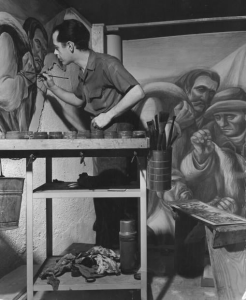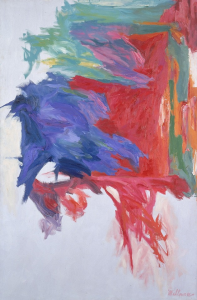
Biography
Edward Millman was born in Chicago in 1907. He studied at the School of the Art Institute in the 1930s, where his teachers were Leon Kroll and John Warner Norton. Kroll was a painter and lithographer, highly regarded for his nude studies. Norton painted and created murals, which became a major interest for Millman.
He married Norma Horton in 1932 and completed a mural for the Century of Progress Exposition in Chicago in 1933. He spent a portion of the years 1934-1935 doing research in mural painting in Mexico. The emphasis upon the sufferings of the poor, as depicted by Orozco and Rivera, became a dominant theme in Millman's later murals.
There were many such works. Millman served as state director for mural projects for the Federal Art Project in Illinois in the years 1935-1936. During this time, he completed murals for the Post Offices in Moline, IL (1935) and Decatur, IL (1936), as well as murals for the Chicago Public Schools. In 1937 he completed a mural for the Chicago Bureau of Water.
In 1937 Millman contributed a linoleum cut print "Shoemaker" to the portfolio "A Gift to Birobidjan." Birobidjan was part of the Autonomous Jewish Oblast that Stalin had formed as a possible homeland for displaced Jews. A 1938 etching, "Flop House," shows more of Millman's strong sentiment for the displaced and downtrodden.
Millman and Mitchell Siporin received a commission in the hotly-contested competition for murals at the St. Louis, MO Post Office. This was the largest award made by the Treasury Department for a set of Post Office murals.
Millman taught fresco painting at Hull House from 1939-1942, while working in lithography and completing a mural for the Lucy Flower Academy High School (1940). During World War II he served as a combat artist (1944-1945), receiving a special citation from the Navy and a Gugenheim Fellowship (1945) in recognition of his work. In 1950 Millman, together with Edward Chavez, Fletcher Martin and Fred Vidar, documented the health needs of Native Americans around the country, culminating in an exhibit at the American Museum of Natural History.
From 1951 on Millman held a series of teaching positions: Indiana University (1951), Washington University of St. Louis (1951-1952), the University of Arkansas (1953), Cornell University (1954), the Layton School of Art (1955), the Univerity of Buffalo (summer sessions, 1955-1956), the Munson Williams Proctor Institute School of Art (1955-1956), and Rensselaer Polytechnic Institute (1956-1964). He was also an artist in residence at the Art Institute (1961-1962) and the Herron Museum of Art (1964). During this period his preferred style of painting moved from the realism of his 1930s murals to a much more contemporary abstract expressionism. He continued to work until his death in at age 57 in 1964.


Critical Analysis
Although Millman was said to have bought his clothes at Brooks Brothers, he was a man of the people insofar a his murals went. Few artists matched his output or his dedication to putting a spotlight on the plight of minorities and the oppressed.
Murals
- Chicago, Illinois - City Hall Service Center: The Blessings of Water
- Chicago, Illinois - Lucy Flower High School: Women's Contribution to American Progress
- Decatur, Illinois - Post Office: Early Pioneers
- Decatur, Illinois - Post Office: Growth of Democracy in Illinois
- Moline, Illinois - Post Office: Ploughshare Manufacturing
- St Louis, Missouri - Post Office: Early Commerce and Trade
- St Louis, Missouri - Post Office: Pre Civil War Missouri
- St Louis, Missouri - Post Office: The River
- St Louis, Missouri - Post Office: The Struggle for Statehood
- St Louis, Missouri - Post Office: The Territory of Missouri
References
- Edward Millman (Modernism in the New City: Chicago Artists, 1920-1950). Biographical text by Lisa Meyerowitz for an art collection selected by Bernard Friedman.
- Edward Millman (Eric Angeloch).
- Edward Millman (Cincinnati Art Galleries, LLC).
- Edward Millman (A Gift to Biro-Bidjan: Chicago, 1937).
- Edward Millman, Artist, Dead, New York Times February 14 (1964). Times obituary for Edward Millman